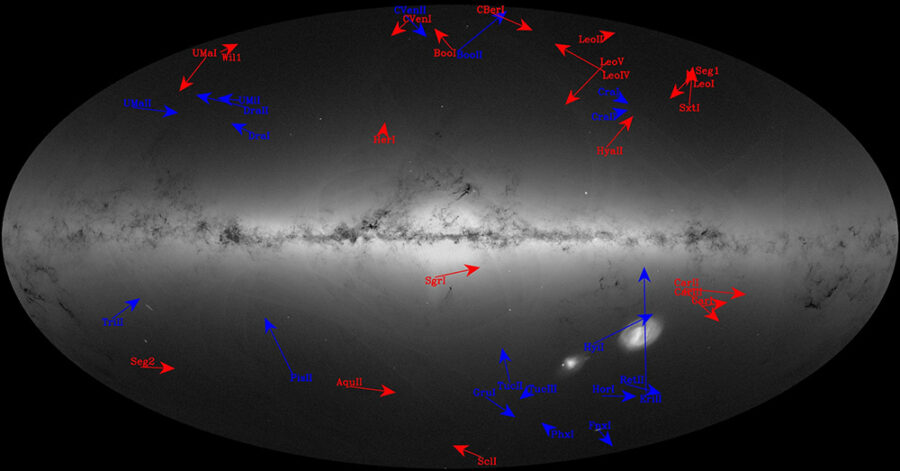New research may explain why satellite galaxies align themselves around the Milky Way.
There’s something strange about the dwarf galaxies around the Milky Way.
These smaller galaxies orbit our own, but many of their orbits align along what astronomers term the vast polar structure: a pancake-shaped plane that intersects our own crepe-thin galaxy. Out of the dozens of known satellites in the Milky Way’s retinue, about half of them, maybe even more, belong to this structure, dotting the plane like raisins in the pancake. What’s more this pancake rotates, the blueberries whirling around the Milky Way in the same direction.

Institute of Astrophysics of the Canary Islands
This alignment has puzzled astronomers since the first hints of it appeared in the 1970s. Cosmological simulations don’t generally predict this effect. Some researchers have even wondered if the problem is with our understanding of dark matter or of gravity itself.
In a paper posted to the astronomy preprint arXiv, Nicolás Garavito Camargo (University of Arizona) and colleagues suggest the focus ought to be on the biggest of all the little fish: the Large Magellanic Cloud (LMC).
The LMC is a massive dwarf, with at least a tenth the mass of the Milky Way. It’s swinging around our galaxy for the first time on a trajectory that aligns with the vast polar structure, and it may have brought a half dozen smaller galaxies in with it. That can’t be a coincidence, right? Astronomers have thought so, too, and several have suggested that the LMC has somehow inspired the mysterious polar structure.
In fact, earlier this year, Jenna Samuel (now at University of Texas, Austin) and colleagues made this case: Samuel’s led simulations to demonstrate that dwarf galaxies tend to align along cosmic pancakes — and stay that way, at least for a while — when there’s a massive dwarf like the LMC in the mix.

S&T / J. Kelly Beatty
The question is how: The LMC and its retinue are only a few of the Milky Way’s many satellites, so it and its attendants can’t account for the plane simply by falling in. Garavito Camargo and colleagues describe how the LMC could have affected the orbits of the other galaxies.
In short, the dwarf galaxy is throwing its weight around, affecting the Milky Way, its dark matter halo, and its satellites, all via the simple force of gravity. Not only does the dwarf pull on the other satellite galaxies ahead of it in its orbit, it also draws the material behind it into a wake. In addition, the researchers realized, they would need to account for their own place in the galaxy.
As it falls in, the LMC has pulled the Milky Way off-center. Our galaxy is enormous, though, and the shift in center of mass has taken time to travel outward. While the inner regions of the galaxy and its halo are already orbiting the new center of mass, the outer regions haven’t gotten the memo yet. So, from our perch in the inner galaxy, we see the outer regions rotate.
“We’re actually in a moving car, when we thought we were just sitting still,” explains coauthor Gurtina Besla (University of Arizona). “You see all these things move by you and you think they’re moving at some speed, but in fact we’re moving along with it and they’re actually moving slightly slower.” In effect, when we see the satellite galaxies moving together in concert, some of that is simply the effect of our own motion — something that we hadn’t considered before.
Garavito Camargo, Besla, and colleagues combined all of these effects in a simulation of the LMC–Milky Way encounter, confirming that the LMC’s infall is capable of reshaping the orbits of numerous objects around the Milky Way.
Pawlowski M., Kroupa P. & Jerjen H. / Monthly Notices of the Royal Astronomical Society 2013
Even taking all these effects together, though, they still might not fully explain the strange alignment of Milky Way satellites. Then again, they don’t have to: After all, cosmological simulations do create planes of satellites, just not ones as organized as the one around the Milky Way.
“The idea is that, after correcting for all these effects, the remaining plane may better resemble the structures predicted in cosmological simulations,” Garavito Camargo says. “All this together can create something that’s kind-of weird and statistically more improbable than what you might find in a generic cosmological simulation.”
“The new work offers a fresh approach and one that is a very thorough and convincing piece of research, which naturally got me and others working on this issue very excited,” says Marcel Pawlowski (Leibniz Institute for Astrophysics Potsdam), who wasn’t involved in the new study. He maintains, however, that there’s still work to be done to understand the structure’s origin.
 1
1









Comments
Rod
December 6, 2021 at 9:09 am
Interesting report here. I note this new report on dwarf galaxies, they are recent newcomers to the MW. Gaia reveals that most Milky Way companion galaxies are newcomers to our corner of space, https://phys.org/news/2021-11-gaia-reveals-milky-companion-galaxies.html
Reference paper, Gaia EDR3 Proper Motions of Milky Way Dwarfs. II Velocities, Total Energy, and Angular Momentum, https://iopscience.iop.org/article/10.3847/1538-4357/ac27a8, 24-Nov-2021.
My observation. 2 Gyr is a short time span in stellar evolution and cosmology for 40 dwarf galaxies in the Milky Way area to recently arrive. The 40 dwarf galaxies all arrived long after the age of the solar system using the meteorite dating paradigm, some 4.56E+9 years old claimed.
You must be logged in to post a comment.
You must be logged in to post a comment.